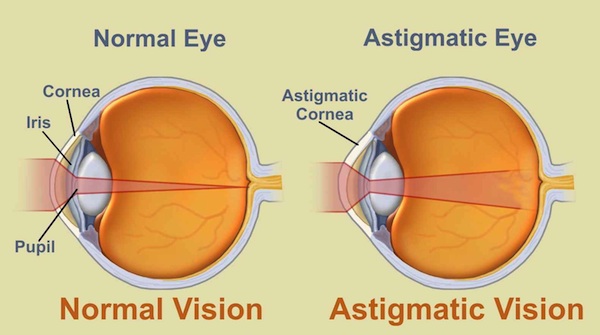Your shopping cart is empty!
MENU
-
Contact Lenses+
- Costume Lenses +
- FAQ +
- Articles +
- Shipping +
- About +
- Contact +
Astigmatism is a vision condition where the cornea (the clear film over the coloured part of your eye) or lens of the eye has an irregular shape, causing blurred vision at all distances. Astigmatism is a very common condition that affects around half of the population.
Our ability to focus relies on light rays entering the eye to a focal point on the retina. If the curvature of the cornea or lens is not the same in all directions (think of a football shape), it will bend the light passing through it preventing the light from focusing properly on the retina thus resulting in blurry vision.
Here’s an image, which shows the difference:

Symptoms of Astigmatism
The most common symptoms of astigmatism are:
Causes of Astigmatism
Astigmatism is generally something that people are born with and can either be an inherited characteristic or something that develops during growth. Sometimes astigmatism can develop following an eye injury or eye surgery. Keratoconus, a degenerative disorder of the eye where the cornea gradually thins and changes to a more conical shape, can also cause astigmatism.
Diagnosis
Your optometrist will conduct a thorough eye exam using a series of tests, which will determine if you have astigmatism. Astigmatism is very common and can change over time. Most children who are born with astigmatism won’t realise that they have it until they have an eye test. Astigmatism in children can affect reading and concentration at school so it’s important to have check ups with your optometrist regularly.
Correction
If your level of astigmatism is quite mild, there may be no correction required. Your optometrist will make an assessment and decide on the best option for you. The most common methods of correcting astigmatism are with prescription glasses or contact lenses. Other methods that are able to correct astigmatism are Orthokeratology and laser eye surgery. Your optometrist can discuss these options in detail with you.